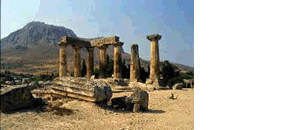 |
|
|
|
|
Class
Prep
|
|
|
|
- "Ain't
Misbehavin'": The Greeks Defend their Gods
-
 The beauty of Homer's epic poetry gave the Iliad/Odyssey classic
status in Greek culture. Homer was standard fare in
the curriculum of Greek students and of non-Greek students who
aspired to the best education.
The beauty of Homer's epic poetry gave the Iliad/Odyssey classic
status in Greek culture. Homer was standard fare in
the curriculum of Greek students and of non-Greek students who
aspired to the best education.
-
- But there was a problem with Homer's classic: the god(s) misbehaved,
or behaved in a manner that later generations found inconceivable. We
saw this when we read Aeschylus' Oresteia: gods fighting
amongst themselves, taking sides with humans, and--if we looked
at Homer--shape-shifting into human and animal bodies so as to
torment or seduce.
-
- Plato was perhaps one of the first to criticize the Homeric
classics, and his critique was scathing. Later Greek
philosophers, including the middle Platonists and the Stoics,
were not so dismissive. The Platonists, for example,
believed that there must be a deeper and other meaning to the
dalliances of the gods, and so they began a technique of interpretation
called "allegorical exegesis" which sought these "other
meanings" (the literal meaning of "allegory"). This
way they could preserve the classical heritage and recognize its
aesthetic beauty, but improve on its philosophical sophistication.
-
- The Stoics were less inclined to allegory, because as rationalists
they did not want to argue that these great poems represented
mythical flights of fancy, still less that they could be interpreted
as meaning something other than what the poets intended. But
their technique of recovering them was not altogether different
from the Platonists, because they found ways for the texts to
mean something other than what they mean literally.
-
- Today, begin with the secondary reading from Tripolitis.
Outline the various philosophical groups she mentions, and
be able to identify their core religious views. When you
turn to Lucian of Samosata's little piece, you'll be reading
a second-century pagan author from Syria who is not so optimistic
about the value of Greek epic and mythology. In this entertaining
dialogue with Zeus, Lucian forces the father of the gods
to admit to the inherent logical flaws of Greek metaphysics.
Try to identify what Lucian's skeptical alter ego, Cyniscus,
teaches Zeus.
-
-
- Assigned Readings
- Primary: Lucian of Samosata, "Zeus Catechized"
(ERes)
- Secondary: Tripolitis, 36-46; online class prep
- Optional: Homer, Iliad, Book 21 (ERes)
-
-
-
- Further Reading
- Attridge, Harold W. "The Philosophical Critique
of Religion under the Early Empire." Aufstieg
und Niedergang der Römischen Welt II.16.1 (1978) 45-78.
-
 Auerbach, Erich. Mimesis: The Representation of
Reality in Western Literature, trans. Willard R. Trask. Princeton,
New Jersey: Princeton University Press, 1953.
Auerbach, Erich. Mimesis: The Representation of
Reality in Western Literature, trans. Willard R. Trask. Princeton,
New Jersey: Princeton University Press, 1953.
-
- Dawson, David. Allegorical Readers and Cultural
Revision in Ancient Alexandria. Berkeley: University
of California Press, 1992.
-
 Dillon, John M. The Middle Platonists: 80 B.C. to
A.D. 220. Ithaca, New York: Cornell University
Press, 1977.
Dillon, John M. The Middle Platonists: 80 B.C. to
A.D. 220. Ithaca, New York: Cornell University
Press, 1977.
-
 Dodds, E. R. The Greeks and the Irrational. Berkeley:
University of California Press, 1951.
Dodds, E. R. The Greeks and the Irrational. Berkeley:
University of California Press, 1951.
-
 Graeser, Andreas. "The Stoic Theory of Meaning." In
The Stoics (ed. John M. Rist; Berkeley: University of California
Press, 1978) 77-100.
Graeser, Andreas. "The Stoic Theory of Meaning." In
The Stoics (ed. John M. Rist; Berkeley: University of California
Press, 1978) 77-100.
-
 Lamberton, Robert. Homer the Theologian: Neoplatonist
Allegorical Reading and the Growth of the Epic Tradition,
The Transformation of the Classical Heritage 9. Berkeley:
University of California Press, 1986.
Lamberton, Robert. Homer the Theologian: Neoplatonist
Allegorical Reading and the Growth of the Epic Tradition,
The Transformation of the Classical Heritage 9. Berkeley:
University of California Press, 1986.
-
 Tate, J. "The Beginnings of Greek Allegory." Classical
Review 41 (1927): 214-15.
Tate, J. "The Beginnings of Greek Allegory." Classical
Review 41 (1927): 214-15.
-
 --------. "Plato and Allegorical Interpretation." Classical
Quarterly 23 (1929) 142-54; Classical Quarterly 24
(1930) 1-10.
--------. "Plato and Allegorical Interpretation." Classical
Quarterly 23 (1929) 142-54; Classical Quarterly 24
(1930) 1-10.
-
 --------. "On the History of Allegorism." Classical
Quarterly 28 (1934) 105-114.
--------. "On the History of Allegorism." Classical
Quarterly 28 (1934) 105-114.
-

 van der Valk, M. Researches on the Text and Scholia
of the Iliad, 2 vols. Leiden: Brill, 1963-1964.
van der Valk, M. Researches on the Text and Scholia
of the Iliad, 2 vols. Leiden: Brill, 1963-1964.
-
 Veyne, Paul. Did the Greeks Believe in Their Myths?,
trans. Paula Wissing. Chicago: University of Chicago
Press, 1988.
Veyne, Paul. Did the Greeks Believe in Their Myths?,
trans. Paula Wissing. Chicago: University of Chicago
Press, 1988.
-
 Whitman, Jon. Allegory: The Dynamics of an Ancient
and Medieval Technique. Cambridge, Massachusetts:
Harvard University Press, 1987.
Whitman, Jon. Allegory: The Dynamics of an Ancient
and Medieval Technique. Cambridge, Massachusetts:
Harvard University Press, 1987.
-
-
- Links
- For further background on allegorical interpretation of
Greek mythology, see the excellent page by Joseph
Farrell, a Professor in the Department of Classical
Studies at the University of Pennsylvania.
-
-
- Sources
- Photograph: John Decopoulos, "Aphrodite, Pan and Eros,
National Archaeological Museum, Athens, Greece," National
Archaeological Museum slide #5, FotoOlympic.
|
|
|
|
|
